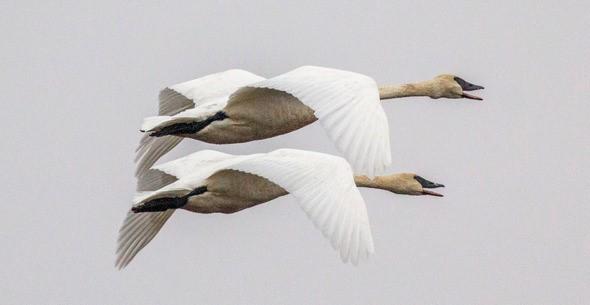
Xplor reconnects kids to nature and helps them find adventure in their own backyard. Free to residents of Missouri.


































Stay in Touch with MDC news, newsletters, events, and manage your subscription

Xplor reconnects kids to nature and helps them find adventure in their own backyard. Free to residents of Missouri.

A monthly publication about conservation in Missouri. Started in 1938, the printed magazine is free to residents of Missouri.






St. Joseph, Mo. – Rare, but becoming more abundant, trumpeter swans are making their annual winter visit to wetlands and lakes in western Missouri. The all-white swans stand out when spotted among other waterfowl such as ducks and geese. Their long, graceful necks arch and bend as they dip heads beneath the surface for food or raise their eyes to look about. In flight, they become long angular birds gliding through the air. They are North America’s largest waterfowl, and among the most graceful.
Trumpeter swans were once almost extinct in the lower 48 states due to unregulated hunting and habitat loss in the 1800s and early 1900s. But conservation efforts have brought nesting populations back in the Upper Midwest and the West. Winter brings migrating trumpeters southward into Missouri. They are often seen in family groups. The swan pairs mate for life. Pairs are often spotted with a group of young, called cygnets, swimming or flying together. The cygnets have a more grayish color than the mature white swans.
A prime place to see trumpeter swans is the Loess Bluffs National Wildlife Refuge near Mound City. The refuge staff observes and counts waterfowl once a week. On Dec. 5, the staff counted almost 3,000 trumpeters using the refuge wetlands.
But trumpeters are also seen in small numbers at MDC conservation areas with managed wetlands, as well as at small community lakes or private lakes or ponds. They require open water for loafing and feeding, and they sometimes visit harvested crop fields. About 40 to 50 trumpeter swans have been spotted recently at the Fountain Grove Conservation Area, said Bryan Anderson, MDC wildlife biologist.
Once trumpeter swans use a wetland or lake as a winter resting place, the family groups will often return in subsequent years. Sightings have become more common as conservation programs enabled their population to increase. A few trumpeter nesting attempts have been documented in Missouri. But the winter flights are what enables Missourians to see and hear trumpeter swans. Their distinctive, long honking vocalizations gave them the “trumpeter” name.
“The populations are slowly growing, and this can be seen as numbers increase seasonally,” said Frank Nelson, MDC wetland systems manager. “Across the state, wetland areas are seeing more numbers of wintering swans. In the past it was notable to see just one, but we are seeing more numbers on an annual basis, which is encouraging.”
For more information on trumpeter swans in Missouri, visit http://short.mdc.mo.gov/44a.